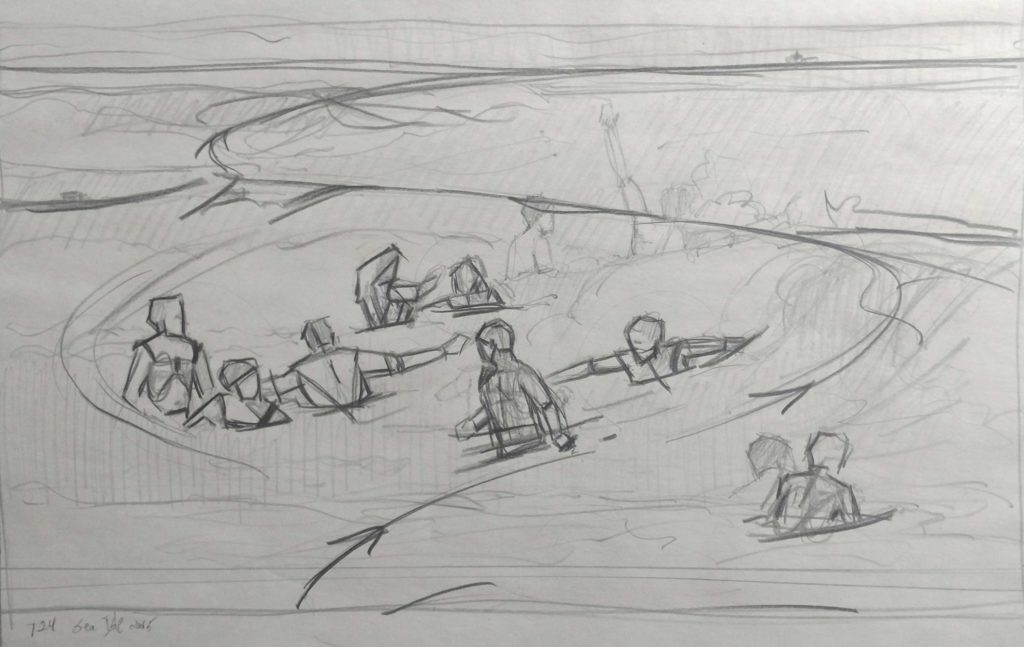
By John Slivjak
www.johnslivjak.com
Water as a Featured Element in a Landscape Painting
Water as a featured element in painting has been used by artists throughout history. Leonardo’s “Mona Lisa” has a river in the background. Hudson River School artists included water in paintings that helped to define American Art. Claude Monet often used rivers and streams as subjects to study the effects of light through color.
There are a few things to consider when painting water:
Perspective
Design and composition
Value study
Color
Linear perspective can be applied to water and waves as they cover a relatively flat surface. The horizon is the point at which the earth’s curvature makes things seem to disappear. Locating the horizon in your design is one of the first steps. A high horizon gives room for more things in the foreground. A low horizon will give more focus to the sky. Objects like boats that sit on water appear smaller as they go back in space. The same is true for the waves that seem to originate at the horizon. Waves that are closer appear larger and more powerful. They appear smaller as they go back into space. Waves come and go quickly and are not always in neat rows that line up with the beach. They usually approach the shore on an, angle requiring artists to understand the principles of linear perspective.


Design and Composition
In my preliminary drawings for “Rising Tide,” I wanted to combine figures in the landscape/seascape. I drew many figures in various activities while down at the shore. I decided on the final version when I felt that the figures in their actions fit the pattern that follows the rhythm of the water’s movement.

In the block-in you can see the figure 8 of water movement. All the figures except one are encircled in the lower half of the 8. I included the figure in the lower right in order to keep viewers’ eyes on the canvas.

Block-in Value Study
Value studies can aid in reducing the complexity of the subject. They can be simple as my wave study or more complex. After establishing your horizon, determine the size and shape of the wave. One dominant wave is better than several.
Understanding the Nature of Waves
Waves develop in a progressive manner. What point of the wave are you going to show? Waves begin as swells, rise to the highest point, then curl and finally crash and dissipate. Value studies are helpful in establishing your lights and dark accents. You can do them quickly with titanium white and ivory black. I use a value scale that goes from white to black with seven values in between. Value studies enable you to experiment painting quickly using large brushes and your palette knife. I try to paint the feel of the movement of the water. You will want to use middle values for most of the study. A more finished value study will have a lightest light and a darkest dark.

Color
There is no formula for painting water. Water is a clear substance. The color of water comes from the color of what is reflected in the water’s surface or what is beneath the surface. Whatever is being reflected — say a clear sky — remember that the reflected color is going to be different. If the water at the horizon looks like the bluest thing, then paint it that way. The sky will be different, usually lighter in value, and you will determine its color by observing. Throughout the day as the sun moves, the color and value of things change. On hazy days the sky and water might appear to blend, eliminating the horizon.
The best way to learn is to paint from nature. Use a limited palette of ultramarine blue, a red such as cadmium red medium and a yellow like yellow ochre. Strong colors like cadmium yellow can get out of hand unless you are used to them.
Begin your color study the same way you started the value study:
Place your horizon, decide on the size and shape of the dominant wave, and experiment with brush sizes (i.e., larger brushes for larger waves).

The Reflective Quality of Water and Simplification
On calm days water can reflect what is on the shore, creating interesting abstract shapes that require the viewer to look and see what it is that is making up the shapes. The rippling effect of the slightest breeze will cause ripples to break up the mirror reflection. The artist should be aware of the direction of the wind causing the ripples. Both of these examples have slight ripples in the foreground.


When painting a subject that includes its reflection, remember that the reflection is neither dimmer nor darker than the object being reflected. The reflected darks should not be as dark and the reflected lights should not be as light. Knowing when to limit detail is often more important in order to gain the effect of the light and time of day. In “5 am,” (above) the harbor was full of sailboats and fishing vessels that had much detail. Including all of the detail would have detracted from the main idea of depicting early morning light.
Like this? Click here to subscribe to PleinAir Today,
from the publishers of PleinAir Magazine.



